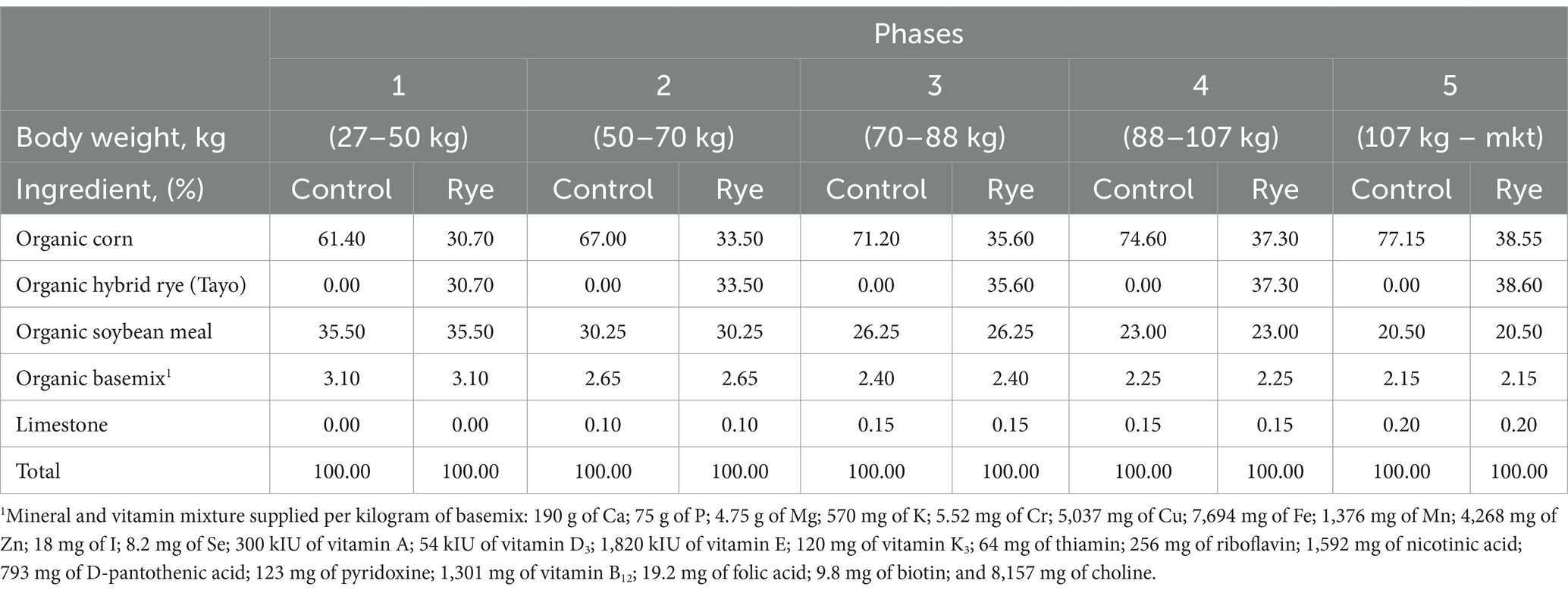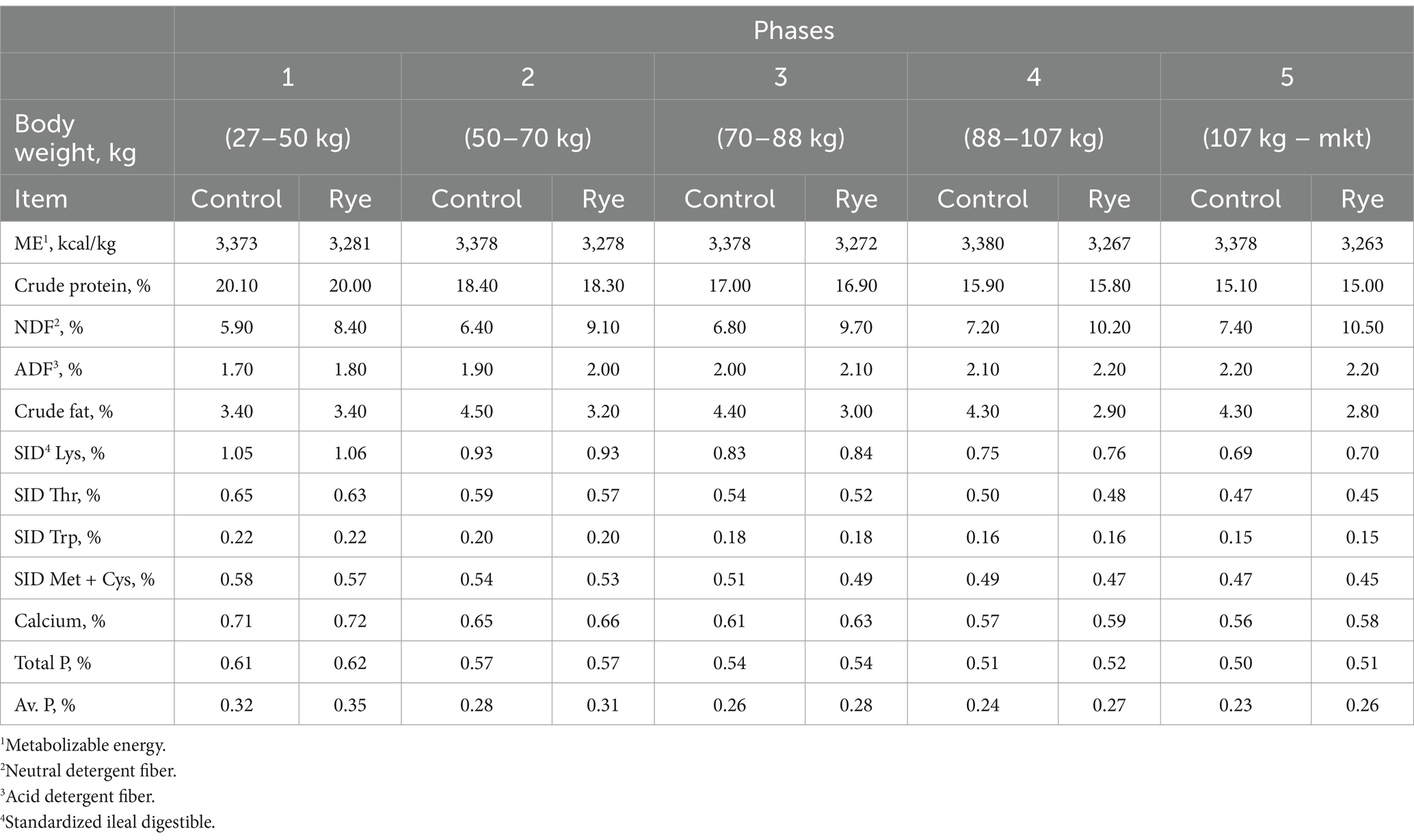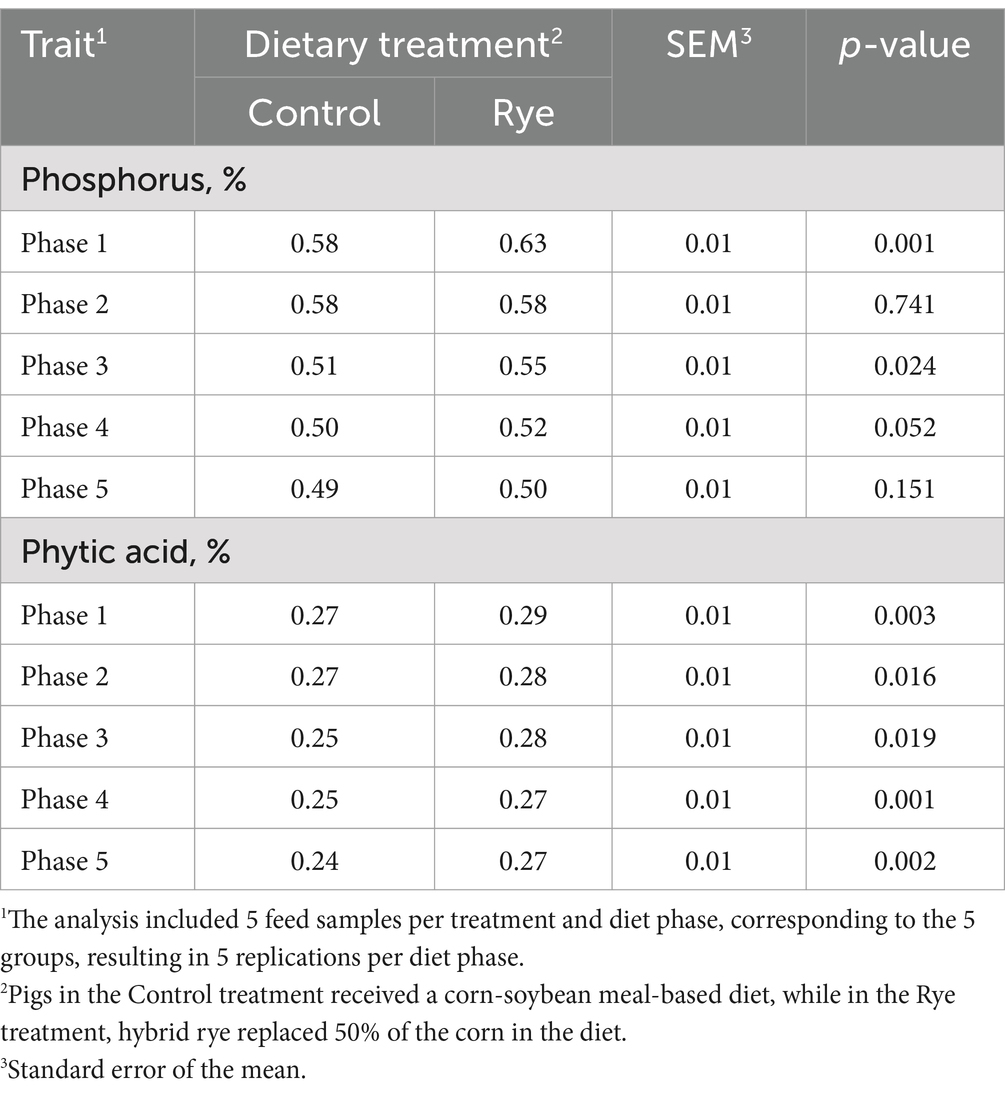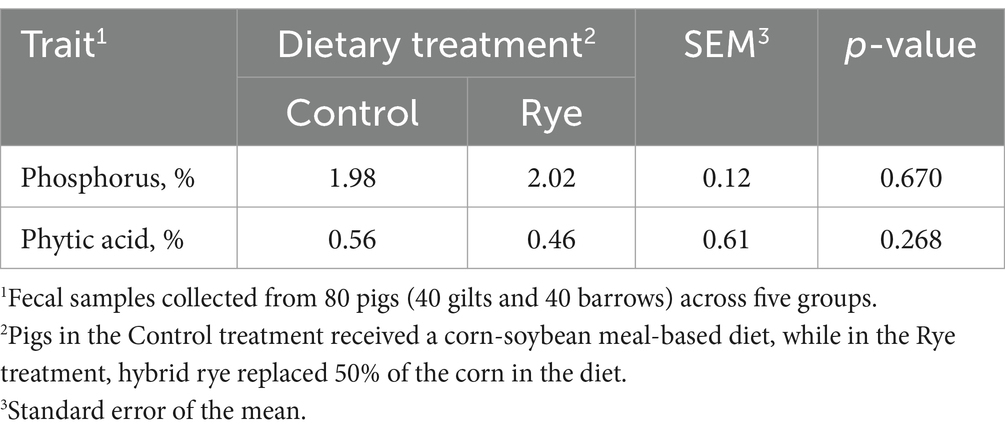- 1Department of Animal Science, University of Minnesota, St. Paul, MN, United States
- 2West Central Research and Outreach Center, University of Minnesota, Morris, MN, United States
This study evaluated the utility of winter hybrid rye as a partial replacement for corn in an organic pig production system. Winter hybrid rye replaced 50% of corn in diets for growing-finishing pigs raised organically to determine pig performance, carcass characteristics, and phosphorus concentrations in fecal samples. A total of 500 pigs (initial body weight = 18.9 ± 2.94 kg) were assigned to either a Control or Rye treatment (50 pigs/pen; 5 pens/treatment) balanced for sex and body weight. Control pigs received a corn-soybean meal diet, while Rye pigs were fed a diet where hybrid rye replaced 50% of the corn in the control diet. Pigs were housed in a hoop barn, with wheat straw bedding provided to Control pigs and rye straw bedding for Rye pigs. Pig performance, including body weight (BW), average daily gain (ADG), average daily feed intake (ADFI), and gain efficiency (G:F) were recorded every 28 days. At the end of the trial, carcass traits such as hot carcass weight (HCW), backfat thickness (BF), and loin eye area (LEA) were measured. Feed samples from each dietary phase were analyzed for nutrient composition, including phosphorus and phytic acid concentrations. Fecal samples from 80 pigs (40 Control and 40 Rye) were collected and analyzed for phosphorus and phytic acid concentration. There were no differences in BW, ADG, ADFI, G:F, or fat-free lean percent of carcass between Control and Rye fed pigs (p > 0.05). However, carcass yield and LEA were lower in Rye-fed pigs (p < 0.05). Mortality tended to be lower in Rye-fed pigs (p = 0.082) probably due to random variation, while morbidity was not different between treatments (p > 0.05). Phosphorus concentrations in Rye diets were higher across most dietary phases (p < 0.05), but there were no differences in phosphorus or phytic acid concentrations in the fecal samples between treatments suggesting improved utilization of dietary phosphorus in Rye-fed pigs. In conclusion, replacing 50% of corn with winter hybrid rye in diets for organically-raised growing-finishing pigs did not affect growth performance but reduced carcass yield.
1 Introduction
Ensuring that pigs meet their energy requirements is essential when formulating swine diets to support optimal growth. In the Midwest U.S., corn is the primary energy source used in conventional pig diets due to its high energy content (National Research Council (NRC), 2012; United States Department of Agriculture (USDA), 2023). Organic swine production systems, which have gained attention with increasing consumer demand for organic products (United States Department of Agriculture (USDA), 2021), take a different approach to feed sourcing compared to conventional systems. Certified organic pig farms are often small and closely integrate crop and livestock systems, allowing nutrient cycling and reducing dependence on feed ingredients like corn that are often purchased from sources external to the farm. Cover crops are important in organic farming rotations and present an opportunity to select crops that benefit both soil health and pig diets. Identifying cover crops that align with organic standards and provide nutritional value for pigs is important for organic systems (Electronic Code of Federal Regulations (eCFR), 2010). Winter hybrid rye, for example, is a small grain with 94% of the metabolizable energy content of corn and can serve as both a feed ingredient and a cover crop in organic farming systems (National Research Council (NRC), 2012).
Rye’s use in swine diets has been limited in the past by the presence of ergot, a toxic fungus that can pose health risks to animals if present in contaminated feed (Geiger and Miedaner, 2009; United States Department of Agriculture (USDA), 2013; Coufal-Majewski et al., 2016). The development of hybrid rye through crossbreeding has addressed this issue by introducing traits such as ergot resistance and higher yield compared to conventional rye (Miedaner and Geiger, 2015; Laidig et al., 2017).
Hybrid rye can also help meet the pig’s phosphorus requirement in swine diets. Phosphorus is important for maintaining skeletal growth, energy metabolism and cell signaling in pigs (Humer et al., 2015). Satisfying dietary phosphorus requirements of pigs can be challenging in organic production systems because use of synthetic phytase in pig diets is prohibited (Electronic Code of Federal Regulations (eCFR), 2010). Phytase is the enzyme that releases phytate-bound phosphorus in feed grains making the phosphorus available for absorption by the pig (National Research Council (NRC), 2012). Without synthetic phytase, much of the phosphorus present in feed grains is unavailable to the pig. Hybrid rye has more intrinsic phytase than corn, which makes phosphorus in rye more available than that present in corn (National Research Council (NRC), 2012; Rodehutscord et al., 2016; McGhee and Stein, 2019; Archs-Toledo et al., 2020). The improved phosphorus availability of rye may reduce the need for supplemental phosphorus in swine diets and decrease phosphorus excretion in manure. Excessive phosphorus in pig manure can lead to phosphorus accumulation in cropland which likely increases risk of phosphorus runoff into nearby waterways (Joern and Sutton, 2019). Phosphorus in the runoff can cause eutrophication of surface water and promote rapid algal growth (Daniel et al., 1998) which has negative environmental impacts.
Given these potential benefits of hybrid rye in swine nutrition and its possible environmental impact, further research is needed to quantify its effects in practical feeding scenarios. Therefore, the objective of this study was to evaluate the effects of replacing 50% of corn with hybrid rye in a certified organic production setting during the growing-finishing period on pig performance and carcass traits, and to determine whether this replacement could improve phosphorus utilization in pigs.
2 Materials and methods
This experiment was conducted at the University of Minnesota’s West Central Research and Outreach Center in Morris, Minnesota. The experimental protocol was approved by the University of Minnesota Institutional Animal Care and Use Committee (IACUC# 2105-39077A).
2.1 Animals, housing and management
Pigs were raised under organic conditions according to the standards set by the National Organic Program (Electronic Code of Federal Regulations (eCFR), 2010). Pigs were offspring of Topigs Norsvin genetics (Landrace × Z-line hybrid sows mated to Tempo line sires; Topigs Norsvin, Burnsville, MN, USA). Weaning occurred at about 6 weeks of age, with piglets continuing to stay in the same bedded farrowing areas for up to 8 weeks of age. Pigs were allowed ad libitum access to water and organic-certified feed. All pigs had outdoor access, and practices such as tail docking, teeth clipping, and ear-notching were not performed. Gilts and barrows received iron injections within their first week of life and male pigs were castrated. To facilitate individual identification, each pig was tagged with a LeeO ear tag (LeeO, Merck & Co., Inc., Rahway, NJ, USA) at about 3 days of age.
2.2 Experimental design
Five hundred pigs in five contemporary groups (100 pigs/group) were used in this study. Two groups were used from September 2022 to February 2023, and three groups from September 2023 to June 2024. At 8 weeks of age, pigs were sorted by weight and sex and assigned to one of two dietary treatments (Control or Rye). Pigs (average body weight = 18.88 kg) were then transferred to the hoop barn and fed a control diet for 2 weeks before dietary treatments started at week 10 of age. The hoop barn measured 12 m × 24 m, and was divided into two equally-sized pens, measuring 6 m × 24 m. Each pen featured a bedded sleeping area (6 m × 18 m) and a concrete floor (6 m × 6 m) for the feeder, water fountain, and access to an outdoor area. Water was supplied via a water fountain with four drinking spaces and feed was provided through a round feeder with 12 feeding spaces. The barn was naturally ventilated through side and end openings. Temperature adjustments in the barn were made by altering the barn openings and amount of bedding provided to pigs. Organically-certified bedding was used consistently with additional bedding provided to ensure dry conditions for nesting and warmth. Within each hoop barn, one pen housed Control pigs (50 pigs/pen) on organic wheat straw bedding, and the other housed Rye pigs (50 pigs/pen) on organic rye straw bedding. Pigs remained in their designated pens until reaching market weight (approximately 128.10 ± 16.44 kg). Daily checks were performed to monitor feeders, water fountains, and pig health. Pigs that became sick and required antibiotic treatment were removed from the experiment. In instances of pig removal or mortality, the removed pig’s identification, date of removal or death, reason for removal, and the pig’s weight were recorded.
2.3 Dietary treatments
Pigs were fed the Control phase 1 diet (Table 1) irrespective of their dietary treatment from week 8 to 10 of age to adapt to their new housing environment in the hoop barn. At week 10, Control pigs received an organic corn and soybean meal-based diet, while Rye pigs were provided with a control diet with 50% of corn replaced by hybrid rye (Tayo variety; KWS Cereals USA, LLC, Champaign, IL, USA). Rye replaced 50% of corn on an equal weight basis with no other adjustments in the diet formulations. Experimental diets were provided in five phases based on average weight of pigs in the pen (Phase 1: 27–50 kg, Phase 2: 50–70 kg; Phase 3: 70–88 kg; Phase 4: 88–107 kg; Phase 5: 107 kg to market weight). Calculated nutrient composition of all diets (Table 2) met or exceeded nutritional requirements for growing-finishing pigs recommended by National Research Council (NRC) (2012).
2.4 Data collection
2.4.1 Pig performance
Pigs were weighed individually at week 8 (before pigs were moved to the hoop barn), at week 10 (at the beginning of the study when pigs received their experimental diets) and every 4 weeks until pigs reached market weight. Final body weight (BW) was recorded at the conclusion of the study from each group. Pigs were identified with an RFID ear tag that interfaced with the livestock scale and a table computer (LeeO, Merck & Co., Inc., Rahway, NJ, USA). This system enabled automatic capture of pig identification and body weight throughout the study. Feeders were emptied before pigs moved to the hoop barn, and after pigs left the hoop barn. Weight of feed was recorded each time feed was added to each feeder. Feeders were weighed, and orts recorded every 4 weeks (when pigs underwent their four-week weighing process) and at the end of the study. Pig BW and feed records were used to calculate average daily feed intake (ADFI) and Gain:Feed (G:F) on a pen basis, and average daily gain (ADG) on an individual pig and pen basis. Two large bales each of wheat and rye straw were weighed when each contemporary group started, and their average weight was used as a reference to determine the weight of additional bales added to the pen for that contemporary group. Bedding usage was recorded every 4 weeks by tracking the number of bales added to the pen.
2.4.2 Carcass evaluation
One to three days before pigs were sent for harvest, pigs were slap-tattooed on the shoulder with a unique number and weighed. A certified technician performed real-time ultrasonic measurements (Exago model, Echo Control Medical, Angouleme, France) of the loin eye area (LEA) and backfat (BF) depth between the 10th and 11th ribs. Digitalization of images was performed using Biosoft Toolbox II for Swine software (Version 2.5.0.6; Biotronics, Inc., Ames, IA, USA). Pigs from the 5 contemporary groups were sent to a processing plant (Hormel Foods, Austin, MN, USA), except 80 pigs (40 gilts and 40 barrows; 4 gilts and 4 barrows per treatment per contemporary group) with body weights closest to the pen’s average weight. These 80 pigs were selected for in-depth characterization of carcass and pork quality traits at the Andrew Boss Laboratory of Meat Science located on the University of Minnesota, Saint Paul campus. Hot carcass weight and midline BF thickness at the last rib were recorded for all pigs at the processing plant. Live weight, hot carcass weight, loin eye area and backfat measurements were used to calculate dressing percentage (DP; Equation 1), standardized fat-free lean (Equation 2), and the percentage of fat-free lean (%FFL) on a live weight (Equation 3) and carcass weight (Equation 4) basis. These calculations utilized the actual DP according to National Pork Producer Council (NPPC) (2000) equations:
2.5 Sample collection and analysis
Fresh fecal samples were collected at the Meat Science Laboratory on the St. Paul campus of the University of Minnesota from pigs harvested for carcass and pork quality evaluation (n = 80). Fecal samples were frozen at −20°C until processed for laboratory analysis. Stored samples were thawed at room temperature, then dried at 55°C for 3 days, and ground before being sent to Eurofins Nutrition Analysis Center (Des Moines, IA, USA). Samples were analyzed for concentrations of phytic acid (method: 2000.12; Association of Analytical Chemists (AOAC), 2023) and phosphorus (method: 984.27; Association of Analytical Chemists (AOAC), 2023).
A sample (1 kg) of each dietary treatment from each phase and group was collected and stored in a freezer at −20°C. Feed samples were sent to Midwest Labs in Omaha, NE for comprehensive analysis of dietary nutrient content, including proximate composition, ADF, and NDF. Total phosphorus and phytic acid concentration were analyzed at Eurofins Nutrition Analysis Center (Des Moines, IA, USA), while amino acid concentrations were analyzed at the University of Missouri Agricultural Experiment Station Chemical Laboratories (Columbia, MO, USA). Additionally, rye grain was sent to Eurofins Nutrition Analysis Center (Des Moines, IA, USA) for ergot analysis (method A4; International Association of Feedingstuff Analysis (IAG), 2008).
2.6 Statistical analysis
The GLIMMIX procedure in SAS (version 9.4, SAS Institute Inc., Cary, NC) was used to evaluate the effects of dietary treatments. Performance variables, including BW, ADG, ADFI, and G:F, were analyzed using a repeated measures analysis with BW at week 10 (after the two-week acclimation) as a covariate. Dietary treatment, time, and their interaction were the fixed effects, group was considered a random effect, and pen was the experimental unit.
Carcass data were analyzed using the GLIMMIX procedure in SAS with pen as the experimental unit. The fixed effect was dietary treatment, and group was considered a random effect. For fecal and feed data, we used GLIMMIX after confirming that data were distributed normally with the Shapiro–Wilk test. The fixed effect was dietary treatment, with group as a random effect. Pigs harvested on the St. Paul campus were excluded from analysis of carcass data because harvest procedures were different from those at Hormel Foods. All means are presented as least squares means and significant treatment differences are indicated at p < 0.05 with recognition of tendencies in the range 0.05 ≤ p ≤ 0.10.
Chi-square analyses were used to assess pigs that were too light for harvest at the commercial processing plant, as well as mortality and morbidity. Pigs considered too light to be sent to the commercial packing plant weighed less than 100 kg and were considered sub-standard.
3 Results
The results reported herein are a portion of a much larger, comprehensive project designed to evaluate use of winter hybrid rye in a combined organic pig production and cropping system. Results related to economic outcomes of rye use in pig diets and consumer eating quality of pork produced from this experiment have been published elsewhere (Kavanagh, 2024). Results related to agronomic considerations and environmental impacts of using hybrid rye will be available in a separate publication.
All diets in this experiment were fed in mash form. Grinding rye to a small, uniform particle size proved difficult for the hammer mill at our research center. After several iterations, average particle size of corn and rye fed in this experiment were 680 microns and 830 microns, respectively. Particle size of other dietary components was the same across both diets because the same lot of each ingredient was used for both Control and Rye diets.
In each dietary treatment and phase, a diet sample from each contemporary group (n = 5) was analyzed to determine actual nutrient composition (Table 3). Data presented are mean values of five analyses for each nutrient.
3.1 Pig performance
At the end of the two-week acclimation period (from week 8 to week 10), BW tended to be higher in the Rye group. Thus, to account for this initial weight difference, BW at week 10 (when the trial began and dietary treatments were introduced) was included as a covariate in the analysis of pig performance throughout the trial. This covariate accounted for a significant portion of the variation in pig performance throughout the experiment. During the experiment, inclusion of rye in the diet had no effect (p > 0.05) on ADG, ADFI or G:F of pigs (Table 4). As expected, time had significant effects on growth performance but we observed no significant interactions between dietary rye inclusion and time. There was no evidence for difference in the number of sub-standard pigs (less than 100 kg BW) between dietary treatments. This was used as a potential indicator of dietary effects on pig performance (Table 5). However, there were no differences in the number of light weight pigs observed between Control and Rye groups (p > 0.05). Morbidity was consistent across treatments throughout the study (p > 0.05), but mortality tended to be higher in the Control group compared to the Rye group (p = 0.082).
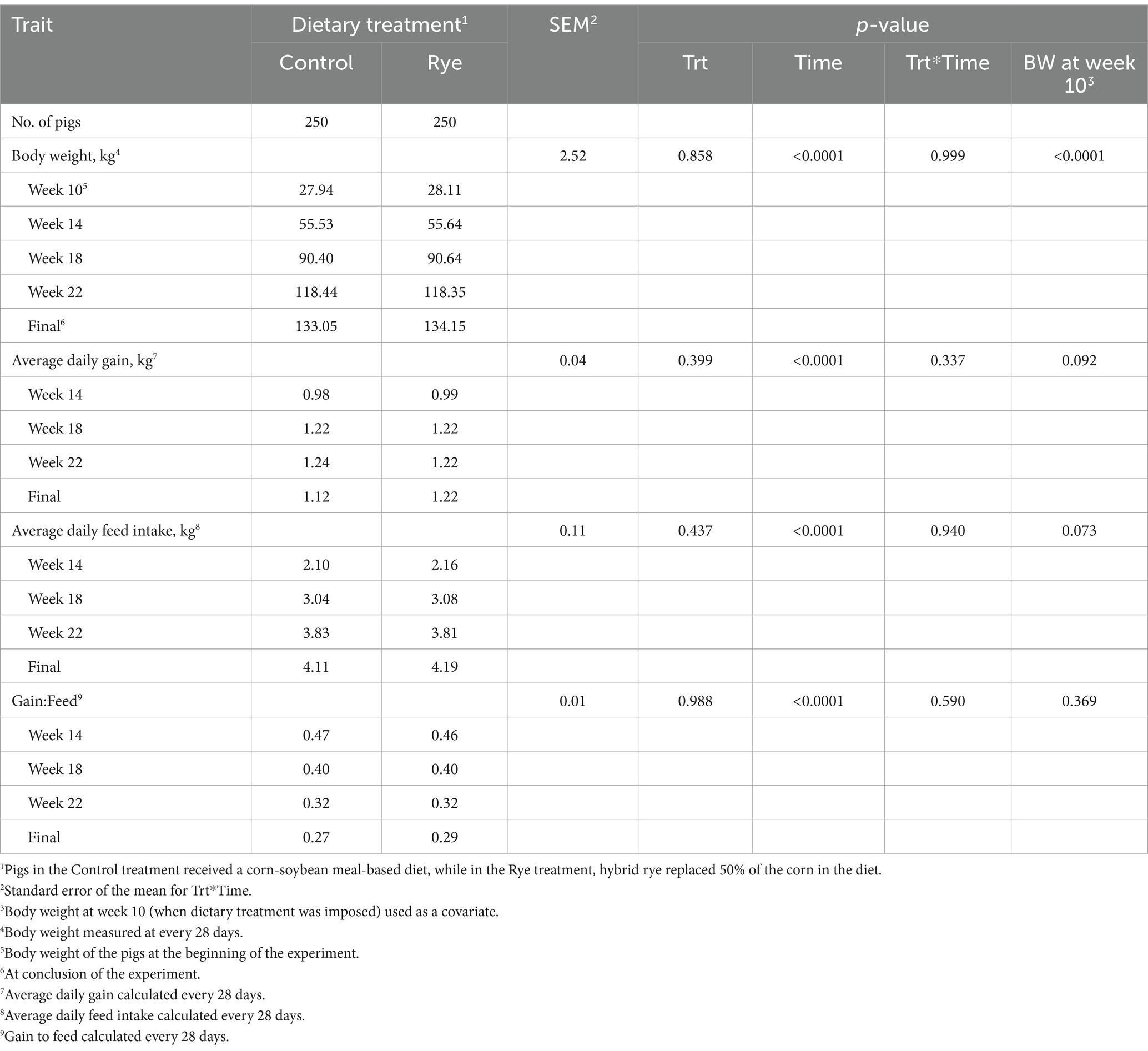
Table 4. Effects of replacing 50% of corn with hybrid rye in growing finishing diets on pig performance.
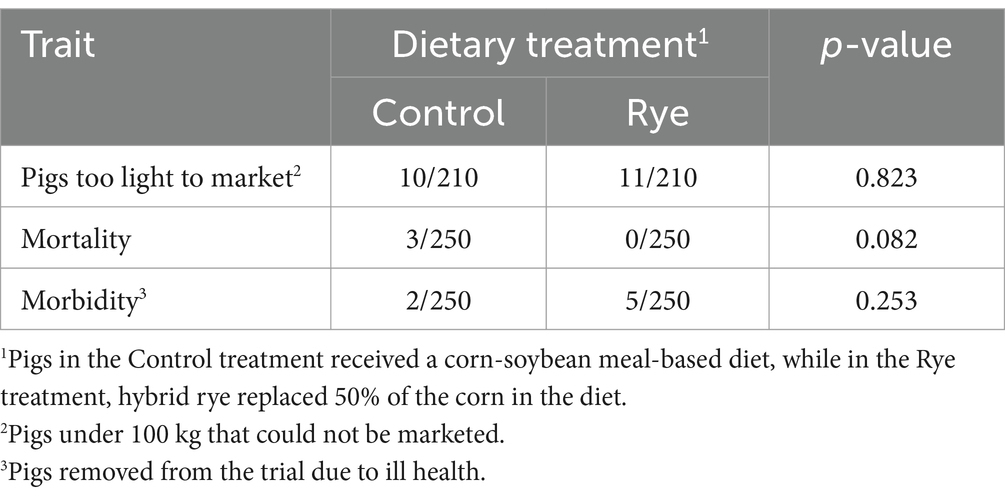
Table 5. Effects of replacing 50% of corn with hybrid rye in growing-finishing diets on light weight pigs, mortality, and morbidity.
Use of straw bedding was similar between Control and Rye pigs. Throughout the experiment, Control pigs required 118.0 kg of wheat straw per pig during the period from week 8 through marketing. Similarly, Rye pigs used 97.7 kg of rye straw per pig during this same period. There was no significant difference in straw use between treatments (p = 0.13; SE = 9.13).
3.2 Carcass characteristics
Market body weight, hot carcass weight, ultrasound backfat depth, standardized fat free lean and percent fat-free lean based on live weight, and carcass weight did not differ between treatments (p > 0.05; Table 6). However, carcass yield and LEA were reduced in pigs fed the Rye diet compared to those fed the Control diet (p < 0.05). Midline BF at the last rib also tended to be lower for Rye-fed pigs (p = 0.070).
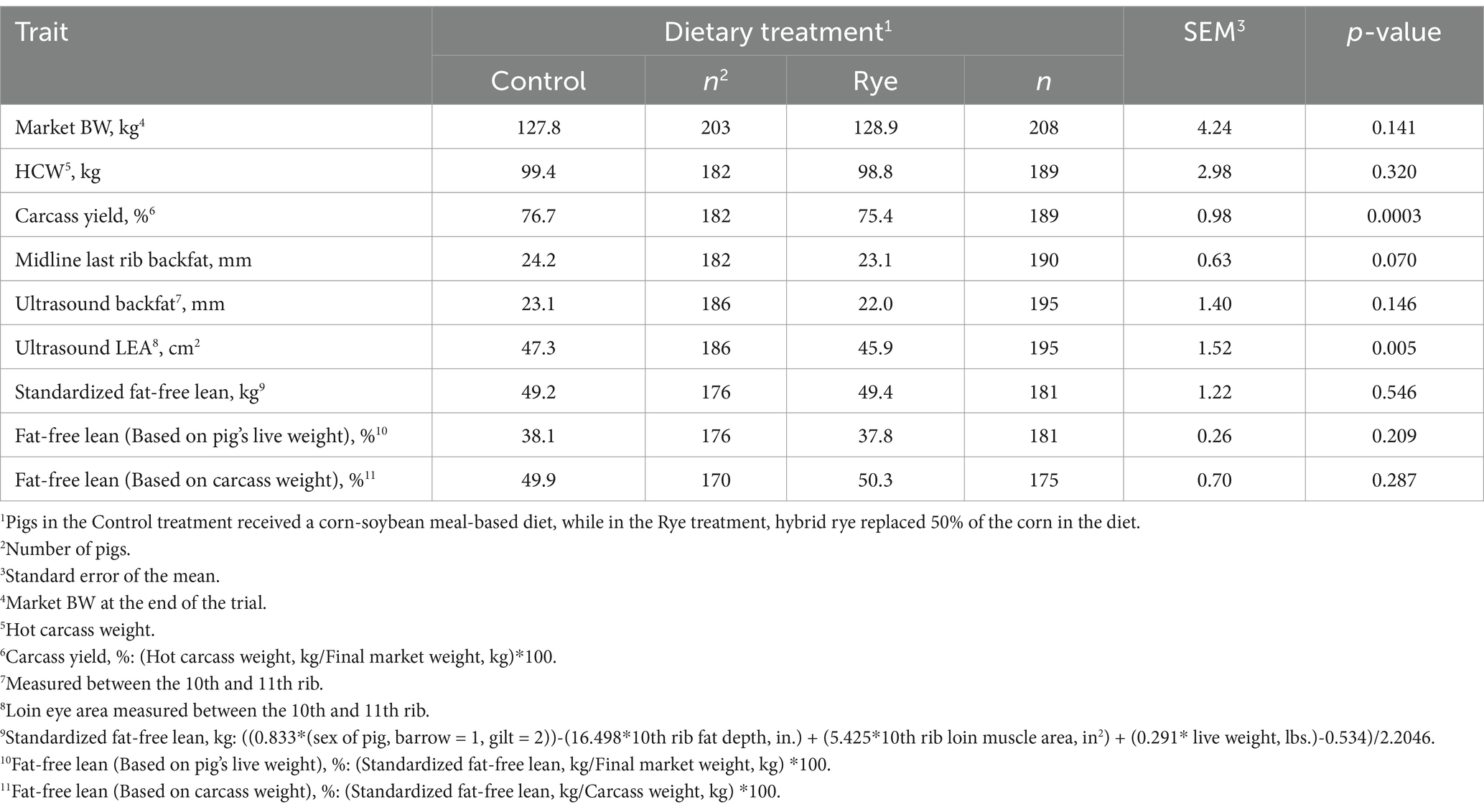
Table 6. Effects of replacing 50% of corn with hybrid rye in growing finishing diets on carcass characteristics.
3.3 Phosphorus concentration in pig diets and feces
Phosphorus concentration in the Rye diet was higher than Control diets in Phases 1 and 3 (p < 0.05), with a tendency to be higher in Phase 4 (p = 0.052; Table 7). However, there were no differences in Phases 2 and 5 (p > 0.05). Phytic acid concentration in the diet was consistently higher in Rye diets compared with Control diets across all phases (p < 0.05). There were no differences in the excreted concentrations of phosphorus and phytic acid between pigs fed Rye and Control-fed pigs (p > 0.05; Table 8).
4 Discussion
Particle size of the rye grain after processing was about 20% larger than that of corn in this study. This difference was greater than expected or desired and could have decreased the G:F ratio for rye-fed pigs compared to Control pigs. However, the similarity of G:F between Control and Rye pigs over each measurement period suggests the larger particle size of rye had no detrimental effects on pig performance. This observation is not surprising considering that the larger particle sized rye comprised only 30–38% of the total diet which would mitigate any negative influences on particle size of the entire diet. Consequently, gain efficiency was not negatively affected by the larger particle size of rye.
Analyzed concentration of crude protein and phosphorus were very similar to the calculated concentrations of these nutrients in each diet. In contrast, analyzed concentrations of crude fat was lower and fiber (NDF and ADF) were higher than expected. However, the relative differences in analyzed nutrient concentrations between diets within phase were very similar to the calculated differences. A very simple approach was used to evaluate dietary hybrid rye in this experiment. Rye replaced 50% of the grain portion of each diet. Because rye contains a higher concentration of lysine with lower standardized digestibility compared to corn (McGhee and Stein, 2018), the SID lysine concentration of Control and Rye diets was comparable between diets. However, the lower ME concentration of rye compared to corn (McGhee and Stein, 2020) marginally reduced energy concentration of the final rye diets. We opted to not correct this energy dilution with added fat because most organic pig farmers do not have feed manufacturing capabilities to add competitively-priced fat (corn oil, soybean oil, tallow, choice white grease) to swine diets in an efficient, low-labor manner. Adding fat to correct for the energy dilution would make our results less applicable to our intended stakeholder group of organic pig farmers.
Rye has a slightly lower energy content compared to corn (3,191 vs. 3,395 Kcal/kg, respectively; National Research Council (NRC), 2012). The marginally lower energy content of rye along with the fact that rye only replaced 50% of the corn in diets likely explains why there were no differences in pig performance during the experiment. Our results align with previous researchers that reported similar outcomes when hybrid rye replaced corn at levels ranging from 0 to 70% (McGhee et al., 2021; Sullivan, 2023). Two factors that could have impacted pig performance are a higher inclusion of hybrid rye (higher than 70%) replacing corn in the pig diet or ergot contamination. Sullivan (2023) reported that when hybrid rye replaced 100% of corn in growing-finishing pig diets, ADG and ADFI decreased. Additionally, ergot contamination in the grain of 0.3% or higher can reduce weight gain and feed intake in growing-finishing pigs (Coufal-Majewski et al., 2016). The hybrid rye provided to pigs from late 2022 to early 2023 contained 0.08% ergot, and the rye fed to pigs from late 2023 through early 2024 contained only 0.02% ergot. These levels of ergot contamination were far below the threshold of 0.3% and did not affect pig performance.
We recorded the number of light weight (less than 100 kg BW) and sub-standard pigs at marketing of each contemporary group. The lack of difference between Control and Rye treatments suggests that dietary rye inclusion did not compromise economic returns to the farmer. Incidence of morbidity was very low and not different between treatments suggesting that health of pigs during the experiment was very good. The tendency for a difference in mortality rate favoring the Rye treatment is likely due to random variation rather than a true treatment effect. The number of pigs involved in this experiment is not sufficient to reliably measure mortality rates (Aaron and Hays, 2004). An overall mortality rate of 0.6% is much lower than industry averages for growing-finishing pigs (Gebhardt et al., 2020) and further supports the notion that pigs were very healthy in this experiment. Corn contains higher ME concentration than rye due to its relatively greater starch content, and lower fiber content (National Research Council (NRC), 2012). The additional energy available in the Control diet could lead to greater deposition of carcass fat and, ultimately, higher carcass yield (Smith et al., 1999; De la Llata et al., 2001). In contrast, Rye diets had a higher NDF concentration than Control diets, with an average of 2.1% higher NDF concentrations across diet phases (Table 3). Arabinoxylan is a type of NDF present in large amounts in hybrid rye (Le Gall et al., 2009; Jürgens et al., 2012; National Research Council (NRC), 2012). Arabinoxylan increases viscosity of digesta which slows passage rate of feed and increases gut fill (Agyekum and Nyachoti, 2017). The slower transit of feed through the digestive tract can also lead to an increase in gastrointestinal organ size as the body adjusts to handle the higher fiber load (Anugwa et al., 1989; Asmus et al., 2014; Coble et al., 2018). The increased weight of the gut and digestive organs increases maintenance energy requirements (Grieshop et al., 2001) which likely diverted energy away from muscle growth and fat accumulation. The potentially increased weight of the gastrointestinal tract and lower energy available for carcass gain (fat and muscle) in Rye-fed pigs compared to Control pigs may explain the reduced carcass yield and smaller LEA of Rye pigs. Our results align with findings by Sullivan (2023) who reported a linear decrease in backfat and carcass yield as hybrid rye inclusion increased in corn-based diets.
Previous researchers have demonstrated that hybrid rye contains more intrinsic phytase compared to other grains (Rodehutscord et al., 2016; Archs-Toledo et al., 2020). A high intrinsic phytase content generally leads to increased phosphorus digestibility in pigs because phytase releases phosphorus from its bound form in phytic acid (McGhee and Stein, 2019; Archs-Toledo et al., 2020). Given these characteristics, we hypothesized that feeding hybrid rye would reduce the amount of phosphorus excreted in feces. Phosphorus and phytic acid concentrations were higher in Rye diets than Control diets during most phases. This was expected as hybrid rye contains more total phosphorus than corn (National Research Council (NRC), 2012). There was no evidence of difference in phosphorus and phytic acid between dietary treatments. Consequently, these observations suggest that pigs fed the Rye diet retained phosphorus more efficiently than Control-fed pigs. This can be concluded because despite having more phosphorus and phytic acid in the diet, the lack of a corresponding increase in phosphorus concentration in feces indicates better absorption and retention of phosphorus. The higher phosphorus utilization in pigs fed Rye diets compared to pigs fed Control diets is likely due to intrinsic phytase activity in hybrid rye. Thus, including hybrid rye in swine diets can improve phosphorus utilization in pig diets and potentially reduce the need for other supplemental phosphorus sources in swine diets. More efficient use of phosphorus contained in natural feedstuffs and reduced use of supplemental phosphorus sources helps reduce demand on finite global supplies of phosphorus (Metson et al., 2012; Scholz et al., 2013) which improves the environmental footprint of pig production.
5 Conclusion
In this study, we demonstrated that replacing 50% of corn with hybrid rye in diets for growing-finishing pig raised organically had no negative effects on pig growth performance. However, pigs fed the Rye diet had lower carcass yield and LEA than Control pigs. Phosphorus concentrations were higher in most phases in Rye-containing diets, and there were no differences in phosphorus concentrations in feces of pigs fed Rye or Control diets suggesting improved utilization of dietary phosphorus in rye-containing diets. These results suggest that hybrid rye can be an effective alternative to corn in diets for growing-finishing pigs raised in organic production systems.
Data availability statement
The raw data supporting the conclusions of this article will be made available by the authors, without undue reservation.
Ethics statement
The animal study was approved by University of Minnesota Institutional Animal Care and Use Committee. The study was conducted in accordance with the local legislation and institutional requirements.
Author contributions
GL: Formal analysis, Writing – review & editing, Data curation, Writing – original draft. MK: Data curation, Writing – review & editing. AH: Data curation, Writing – review & editing. LJ: Conceptualization, Formal analysis, Methodology, Supervision, Writing – review & editing. YL: Conceptualization, Funding acquisition, Methodology, Project administration, Supervision, Writing – review & editing.
Funding
The author(s) declare that financial support was received for the research and/or publication of this article. This work was supported by the Organic Research and Extension Initiative Program (Award# 2021-53100-34894) from the USDA National Institute of Food and Agriculture.
Acknowledgments
This manuscript was extracted from G. Lima’s Master of Science thesis at the University of Minnesota, St. Paul, MN (https://conservancy.umn.edu/bitstreams/3fedac7d-8c0a-4917-a442-047d1e05514f/download).
Conflict of interest
The authors declare that the research was conducted in the absence of any commercial or financial relationships that could be construed as a potential conflict of interest.
Generative AI statement
The authors declare that no Gen AI was used in the creation of this manuscript.
Publisher’s note
All claims expressed in this article are solely those of the authors and do not necessarily represent those of their affiliated organizations, or those of the publisher, the editors and the reviewers. Any product that may be evaluated in this article, or claim that may be made by its manufacturer, is not guaranteed or endorsed by the publisher.
Abbreviations
ADF, Acid detergent fiber; ADFI, Average daily feed intake; ADG, Average daily gain; BF, Backfat thickness; BW, Body weight; G:F, Gain efficiency; HCW, Hot carcass weight; LEA, Loin eye area; NDF, Neutral detergent fiber.
References
Aaron, D. K., and Hays, V. W. (2004). How many pigs? Statistical power considerations in swine nutrition experiments. J. Anim. Sci. 82, E245–E254. doi: 10.2527/2004.8213_supplE245x
Association of Analytical Chemists (AOAC). (2023). Official methods of analysis. Available online at: https://www.aoac.org/official-methods-of-analysis/ (Accessed October 15, 2024).
Agyekum, A. K., and Nyachoti, C. M. (2017). Nutritional and metabolic consequences of feeding high-fiber diets to swine: a review. Engineering 3, 716–725. doi: 10.1016/j.eng.2017.03.010
Anugwa, F. O. I., Varel, V. H., Dickson, J. S., Pond, W. G., and Krook, L. P. (1989). Effects of dietary fiber and protein concentration on growth, feed efficiency, visceral organ weights and large intestine microbial populations of swine. J. Nutr. 119, 879–886. doi: 10.1093/jn/119.6.879
Archs-Toledo, J. L., McGhee, M. L., Mateos, G. G., and Stein, H. H. (2020). Intrinsic phytase in hybrid rye increases the digestibility of phosphorus in corn and soybean meal in diets fed to growing pigs. J. Anim. Sci. 98, 1–6. doi: 10.1093/jas/skaa295
Asmus, M. D., De Rouchey, J. M., Tokach, M. D., Dritz, S. S., Houser, T. A., Nelssen, J. L., et al. (2014). Effects of lowering dietary fiber before marketing on finishing pig growth performance, carcass characteristics, carcass fat quality, and intestinal weights. J. Anim. Sci. 92, 119–128. doi: 10.2527/jas.2013-6679
Coble, K. F., DeRouchey, J. M., Tokach, M. D., Dritz, S. S., Goodband, R. D., and Woodworth, J. C. (2018). Effects of withdrawing high-fiber ingredients before marketing on finishing pig growth performance, carcass characteristics, and intestinal weights. J. Anim. Sci. 96, 168–180. doi: 10.1093/jas/skx048
Coufal-Majewski, S., Stanford, K., McAllister, T., Blakley, B., McKinnon, J., Chaves, A. V., et al. (2016). Impacts of cereal ergot in food animal production. Front. Vet. Sci. 3:15. doi: 10.3389/fvets.2016.00015
Daniel, T. C., Sharpley, A. N., and Lemunyon, J. L. (1998). Agricultural phosphorus and eutrophication: a symposium overview. J. Environ. Qual. 27, 251–257. doi: 10.2134/jeq1998.00472425002700020002x
De la Llata, M., Dritz, S. S., Tokach, M. D., Goodband, R. D., Nelssen, J. L., and Loughin, T. M. (2001). Effects of dietary fat on growth performance and carcass characteristics of growing-finishing pigs reared in a commercial environment. J. Anim. Sci. 79, 2643–2650. doi: 10.2527/2001.79102643x
Electronic Code of Federal Regulations (eCFR). (2010). Title 7: Agriculture. Part 205–national organic program. Available online at: https://www.ecfr.gov/current/title-7/subtitle-B/chapter-I/subchapter-M/part-205?toc=1 (Accessed April 12, 2024).
Geiger, H. H., and Miedaner, T. (2009). “Rye (Secale cereale L.)” in Cereals. ed. M. J. Carena (New York, NY: Springer U.S.), 157–181.
Gebhardt, J. T., Tokach, M. D., Dritz, S. S., Woodworth, J. C., Goodband, R. D., and DeRouchey, J. M. (2020). Practical application of sample size determination models for assessment of mortality outcomes in swine field trials. Kansas Agric. Exp. Stn. Res. Rep. 6:Article 23. doi: 10.4148/2378-5977.7997
Grieshop, C. M., Reese, D. E., and Fahey, G. C. Jr. (2001). “Nonstarch polysaccharides and oligosaccharides in swine nutrition” in Swine nutrition. eds. A. J. Lewis and L. L. Southern (New York, NY: CRC Press), 107–130.
Humer, E., Schwarz, C., and Schedle, K. (2015). Phytate in pig and poultry nutrition. J. Anim. Physiol. Anim. Nutr. (Berl). 99, 605–625. doi: 10.1111/jpn.12258
International Association of Feedingstuff Analysis (IAG). (2008). Section feedingstuff microscopy-determination of ergot. Available online at: https://www.iag-micro.org/files/iag-a4_ergot.pdf (Accessed October 15, 2024).
Joern, B.C., and Sutton, A.L. (2019). Phosphorus management in pork production. Swine Extension. Available online at: https://swine.extension.org/phosphorus-management-in-pork-production (Accessed April 12, 2024).
Jürgens, H. U., Jansen, G., and Wegener, C. B. (2012). Characterisation of several rye cultivars with respect to arabinoxylans and extract viscosity. J. Agric. Sci. 4:1. doi: 10.5539/jas.v4n5p1
Kavanagh, M. (2024). The impact of growing winter hybrid rye to feed and bed organic pigs on pork quality and economic viability. [master's thesis]. St. Paul (MN): University of Minnesota.
Laidig, F., Piepho, H. P., Rentel, D., Drobek, T., Meyer, U., and Huesken, A. (2017). Breeding progress, variation, and correlation of grain and quality traits in winter rye hybrid and population varieties and national on-farm progress in Germany over 26 years. Theor. Appl. Genet. 130, 981–998. doi: 10.1007/s00122-017-2865-9
Le Gall, M., Serena, A., Jørgensen, H., Theil, P. K., and Bach Knudsen, K. E. (2009). The role of whole-wheat grain and wheat and rye ingredients on the digestion and fermentation processes in the gut - a model experiment with pigs. Br. J. Nutr. 102, 1590–1600. doi: 10.1017/S0007114509990924
McGhee, M. L., and Stein, H. H. (2018). Apparent and standardized ileal digestibility of amino acids and starch in hybrid rye, barley, wheat, and corn fed to growing pigs. J. Anim. Sci. 96, 3319–3329. doi: 10.1093/jas/sky206
McGhee, M. L., and Stein, H. H. (2019). Effects of microbial phytase on standardized total tract digestibility of phosphorus in hybrid rye, barley, wheat, corn, and sorghum fed to growing pigs. Transl. Anim. Sci. 3, 1238–1245. doi: 10.1093/tas/txz088
McGhee, M. L., and Stein, H. H. (2020). The apparent ileal digestibility and the apparent total tract digestibility of carbohydrates and energy in hybrid rye are different from some other cereal grains when fed to growing pigs. J. Anim. Sci. 98, 1–10. doi: 10.1093/jas/skaa218
McGhee, M. L., Harsh, B. N., and Stein, H. H. (2021). High inclusion rates of hybrid rye instead of corn in diets for growing-finishing pigs do not influence the overall growth performance and most carcass traits are not influenced by hybrid rye. J. Anim. Sci. 99, 1–8. doi: 10.1093/jas/skab324
Metson, G. S., Bennett, E. M., and Elser, J. J. (2012). The role of diet in phosphorus demand. Environ. Res. Lett. 7:044043. doi: 10.1088/1748-9326/7/4/044043
Miedaner, T., and Geiger, H. H. (2015). Biology, genetics, and management of ergot (Claviceps spp.) in rye, sorghum, and pearl millet. Toxins 7, 659–678. doi: 10.3390/toxins7030659
National Pork Producer Council (NPPC) (2000). Pork composition and quality assessment procedures. Des Moines, IA: Natl. Pork Board.
National Research Council (NRC) (2012). Nutrient requirements of swine. 11th Revised Edn. Washington, DC: The National Academies Press.
Rodehutscord, M., Rückert, C., Maurer, H. P., Schenkel, H., Schipprack, W., Bach Knudsen, K. E., et al. (2016). Variation in chemical composition and physical characteristics of cereal grains from different genotypes. Arch. Anim. Nutr. 70, 87–107. doi: 10.1080/1745039X.2015.1133111
Scholz, R. W., Ulrich, A. E., Eilittä, M., and Roy, A. (2013). Sustainable use of phosphorus: a finite resource. Sci. Total Environ. 461-462, 799–803. doi: 10.1016/j.scitotenv.2013.05.043
Smith, J. W., Tokach, M. D., O’Quinn, P. R., Nelssen, J. L., and Goodband, R. D. (1999). Effects of dietary energy density and lysine: calorie ratio on growth performance and carcass characteristics of growing-finishing pigs. J. Anim. Sci. 77, 3007–3015. doi: 10.2527/1999.77113007x
Sullivan, C. (2023). The impact of increasing dietary levels of hybrid rye on growing-finishing pig performance, carcass characteristics, and meat quality. [master's thesis]. Brookings (SD): South Dakota State University.
United States Department of Agriculture (USDA). (2013). Grain inspection handbook – book II: grain grading procedures. Available online at: https://www.ams.usda.gov/sites/default/files/media/Book2.pdf (Accessed April 18, 2024).
United States Department of Agriculture (USDA). (2021). National agricultural statistics service-newsroom. Available online at: https://www.nass.usda.gov/Newsroom/archive/2021/index.php (Accessed 18 April 2024).
United States Department of Agriculture (USDA). (2023). Feed grains sector at a glance. Available online at: https://www.ers.usda.gov/topics/crops/corn-and-other-feed-grains/feed-grains-sector-at-a-glance/ (Accessed September 14, 2024).
Keywords: hybrid rye, performance, carcass traits, growing-finishing, pigs
Citation: Lima G, Kavanagh M, Hilbrands A, Johnston LJ and Li Y (2025) Dietary winter hybrid rye minimally influences performance and carcass characteristics of organically-raised growing-finishing pigs. Front. Sustain. Food Syst. 9:1576412. doi: 10.3389/fsufs.2025.1576412
Edited by:
Johann G. Zaller, University of Natural Resources and Life Sciences Vienna, AustriaReviewed by:
Guoqing Cao, Shanxi Agricultural University, ChinaAndres Tolosa, Benson Hill Biosystems, Inc., United States
Ryan Samuel, South Dakota State University, United States
Copyright © 2025 Lima, Kavanagh, Hilbrands, Johnston and Li. This is an open-access article distributed under the terms of the Creative Commons Attribution License (CC BY). The use, distribution or reproduction in other forums is permitted, provided the original author(s) and the copyright owner(s) are credited and that the original publication in this journal is cited, in accordance with accepted academic practice. No use, distribution or reproduction is permitted which does not comply with these terms.
*Correspondence: Gabriella Lima, Z2FicmllbGxhY3ZlbG9zb0Bob3RtYWlsLmNvbQ==
 Gabriella Lima
Gabriella Lima Megan Kavanagh
Megan Kavanagh Adrienne Hilbrands2
Adrienne Hilbrands2 Lee J. Johnston
Lee J. Johnston Yuzhi Li
Yuzhi Li